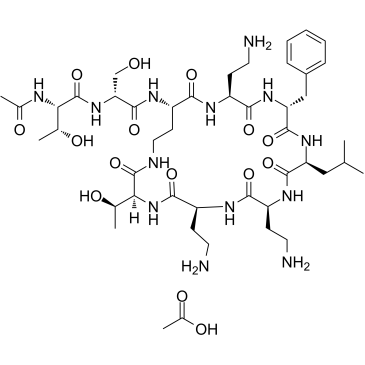SPR741 acetate (Synonyms: NAB741 acetate) |
| Catalog No.GC38947 |
SPR741 acetate (NAB741 acetate) is a cationic peptide derived from polymyxin B and is a potentiator molecule.
Products are for research use only. Not for human use. We do not sell to patients.

Sample solution is provided at 25 µL, 10mM.
SPR741 acetate (NAB741 acetate) is a cationic peptide derived from polymyxin B and is a potentiator molecule. SPR741 acetate increases the permeability of the outer membrane of Gram-negative bacteria and is used to treat severe Gram-negative bacteria infections. SPR741 acetate inhibits multidrug-resistant Gram-negative bacteria. The spectrum of activity of the antibiotic can be widened when used in combination with SPR741 acetate[1][2].
SPR741 potentiates antibiotics that are substrates of the AcrAB-TolC efflux pump in E. coli, effectively circumventing the contribution of this pump to intrinsic antibiotic resistance. The intrinsic resistance of E. coli to certain antibiotics that is mediated by both the outer membrane and the AcrAB-TolC efflux system can be overcome, or circumvented, by combining the antibiotic with SPR741 but that potentiation of intrinsic resistance due primarily to efflux may be limited[1].SPR741 lacks significant antibacterial activity as a stand-alone agent but interacts with the outer membrane of Gram-negative bacteria to increase permeability and thereby improve the accumulation of coadministered antibiotics inside the pathogen[2].
SPR741 has the ability to permeabilize the outer membrane of Gram-negative bacteria, thus sensitizing them to hydrophobic antibiotics. SPR741 has a significantly safety profile of compared to that of polymyxin B, which suffers severe, dose-limiting nephrotoxicity in humans. In multiday rodent and nonhuman primate studies, polymyxin B exhibited nephrotoxicity at a far-lower exposure-normalized dose than SPR741[1].
[1]. Corbett D, et al. Potentiation of Antibiotic Activity by a Novel Cationic Peptide: Potency and Spectrum of Activity of SPR741. Antimicrob Agents Chemother. 2017 Jul 25;61(8). pii: e00200-17. [2]. Eckburg PB, et al. Safety, Tolerability, Pharmacokinetics, and Drug Interaction Potential of SPR741, an Intravenous Potentiator, after Single and Multiple Ascending Doses and When Combined with β-Lactam Antibiotics in Healthy Subjects. Antimicrob Agents Chemother. 2019 Aug 23;63(9). pii: e00892-19.
Average Rating: 5 (Based on Reviews and 32 reference(s) in Google Scholar.)
GLPBIO products are for RESEARCH USE ONLY. Please make sure your review or question is research based.
Required fields are marked with *




















